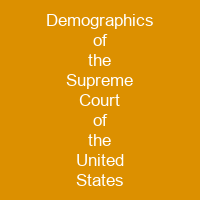The Supreme Court has a majority from the Northeastern United States, with five justices from states to the north and east of New York. Until the appointment of Amy Coney Barrett of Indiana in 2020, most recent Justices had been from the Midwest. The most recent justice who retired in 2010 had been JohnPaul Stevens who worked in Maryland while living in Washington D. C.
About Demographics of the Supreme Court of the United States in brief

The Court’s first two female justices voted together no more often than with their male colleagues, and historian Thomas R. Marshall writes that no particular ‘female perspective’ can be discerned from their opinions. For most of the existence of the Court, geographic diversity was a key concern of presidents in choosing justices to appoint. George Washington was careful to make appointments with no two justices serving at the same time hailing from the same state. Abraham Lincoln broke with this tradition during the Civil War, and by the late 1880s presidents disregarded it with increasing frequency. Until 1867, the sixth seat was reserved as the “southern seat” Until Cardozo’s appointment in 1932, the third seat were reserved for New Englanders. Until the retirement of Hugo Black in 1971, there was always a southerner on the bench. The importance of regionalism declined, but it still arose from time to time, says Frum, including in the 1970s, when Nixon unsuccessfully nominated Southerners Clement Haynsworth of South Carolina, G. Harrold Carswell of Florida and Herschel Friday of Arkansas, before finally succeeding with the nomination of Harry Blackmun of Minnesota. In the 1990s, the Supreme Court had a majority of justices born in New York and New Jersey.
You want to know more about Demographics of the Supreme Court of the United States?
This page is based on the article Demographics of the Supreme Court of the United States published in Wikipedia (as of Jan. 04, 2021) and was automatically summarized using artificial intelligence.







